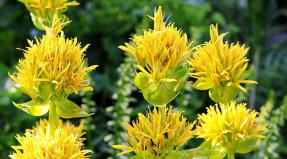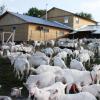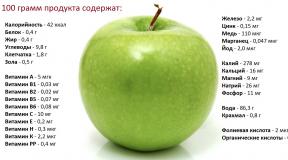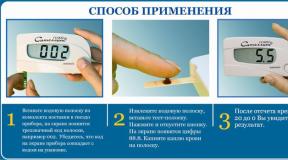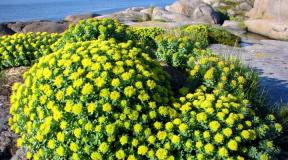At what temperature of the earth are tomatoes planted. When to plant tomato seedlings in a greenhouse. Soil preparation and planting tomato seeds
Usually, in the middle zone of our country, tomato seedlings are first grown and only then they are planted in open ground.
The fact is that the number of warm days in these regions is not enough for the full ripening of the fruits of this vegetable crop.
Therefore, vegetable growers first sow seeds at home in special containers and grow full-fledged strong seedlings. AND only when the seedlings grow several permanent leaves, they can be planted in prepared beds on the site.
Read also:
How to prepare seedlings for planting in open ground
But you need to know when to plant tomatoes in the ground, at what temperature. The fact is that tomato seedlings are sensitive to night frosts on the soil, so you should not rush to plant this vegetable crop. But you need to harden the seedlings while they are growing at home. Hardened seedlings can withstand cooler temperatures after planting outdoors, but weaker seedlings will freeze and die.
The procedure for hardening seedlings should be carried out gradually. First you should open the window above the containers with planted tomatoes. Then take out tomato seedlings on a balcony or loggia during the daytime. And in a few days subject to night temperature above +8°С you can leave seedlings on the balcony all the time. Typically, such hardening is carried out at least a week before planting seedlings on permanent place.

At what temperature are tomatoes planted in beds
What temperature can tomato seedlings withstand? You need to know this so as not to expose the seedlings unwanted impact cold. Usually, hardened tomato seedlings can withstand night temperatures of at least + 8 ° C.
V preventive purposes Tomato seedlings are usually sprayed with Bordeaux mixture before planting in the ground - this procedure will help the tomatoes resist blossom end rot and other diseases.
Also, experienced vegetable growers advise a few days before planting the seedlings to cut off their bottom two leaves. This procedure allows the seedlings to take root faster in the garden, and the first brushes with flowers will form earlier.
You should also wait for the soil warmed up to +11 - 12 ° С. To make sure the ground is warm enough to plant seedlings, gardeners use an outdoor thermometer. It must be placed in the ground by 4 - 5 cm and held for 10 minutes. And only if the thermometer shows the required temperature, you can start planting a tomato. And it is better to plant this vegetable crop on cloudy days, or in the evening, so that the seedlings take root better.

Hardening of tomato seedlings allows them to take root faster in the beds, where it is colder than at home, the wind blows, and the bright sun warms. Tomato seedlings are planted in different regions at different times. In this case, they are guided by the nighttime ambient temperature.
At what temperature do tomato seedlings die? Usually strong seedlings of tomatoes, which managed to take root in open field can withstand temperatures down to -1°C. But at lower temperatures, even hardened seedlings freeze.
How to plant tomato seedlings in a greenhouse?
What temperature should be for tomato seedlings in a greenhouse? Usually waiting when the land is in the greenhouse warm up to 14°C to a depth of at least 13 cm. The temperature of the soil is also measured with an ordinary thermometer.
If the lower foliage of tomatoes touches the ground, then it should be removed. Remove leaves in the morning so that the wound on the plant has time to heal until the evening.

Tomato soil temperature is very important for plant growth. This parameter should be observed during planting seedlings. The optimal temperature regime is the key to the successful formation of the plant, which leads to a bountiful harvest.
Since this vegetable crop is a very heat-loving plant, it is necessary to plant tomatoes taking into account some factors. Among them, soil temperature is of no small importance.
What temperature can seedlings withstand? For the night and daytime periods, these values may be different. However, when determining them, it is necessary to focus on the stage of cultivation: seed, seedling, formation of color or fruit of the culture.
It is necessary to start germinating tomatoes from the moment when the temperature reaches 15 ºС. In order for the germination process to be carried out intensively, it is necessary to ensure an increase in the parameter to 27 ºС. After the event, you can immediately notice that the seedlings of tomatoes begin to grow rapidly.
After this stage has been completed and the planned result has been achieved, it is necessary to resort to hardening the plant. Usually seedlings are returned to the regime at 15 ºС. This event is aimed at favorable cultivation, after which the seedlings will not reach up. This technique at the considered temperature allows the root system of tomato seedlings to form properly, even if the tomatoes are in conditions of low light levels.

The temperature regime, which corresponds to 10 ºС, ensures the cessation of plant growth. If this parameter exceeds 30 ºС, then the flowering process slows down or stops altogether. This leads to the drying of the formed ovary. An incorrectly selected temperature parameter does not allow pollen to ripen properly.
If seedlings are kept at temperatures above 43 ºС and below 5 ºС, the plant may die even when normal values other parameters (lighting, soil moisture level, etc.). The temperature regime, the value of which is less than 1 ºС, leads to instant death.
Favorable indicators
The optimum temperature, which allows tomato seedlings to grow correctly and with a good result, is 21 ºС, which is typical for the daytime. And at night, the specified value is allowed to decrease to 16 ºС.
For high-quality growth of tomatoes in open ground, it must be taken into account that the temperature of the earth should be about + 20 ... + 22 ºС. If the soil temperature is less than 16 ºС, then the following negative processes occur:
- There is no development of adventitious roots, because of this, the root system weakens and grows poorly.
- There is no optimal access to sources of moisture.
- The degree of absorption of mineral fertilizers (phosphorus, nitrogen) is reduced.
All of the above factors increase the risk of seedling death.

If you plant tomatoes at too low a temperature, then this causes a complete cessation of the absorption of all incoming nutrients by the root system. However, gardeners and gardeners should take into account that overheated soil also has a negative effect on the plant. Namely, the rate of its growth and the abundance of fruiting.
When planning a transplant of tomatoes, you need to determine the time for sowing seeds, taking into account their permanent place of growth. The decision should be based on the climatic conditions and characteristics of the selected variety. Low-growing varieties are grown at least 50 days in advance. The process can take up to 70 days to complete. If the gardener chooses one of the giant varieties, then the period can be extended to 90 days.
It is possible to plant tomatoes in open ground, if the location of the site coincides with moderate climatic conditions, already in the very first days of June. In closed ground conditions, the period shifts if the gardener takes into account the temperature regime of the greenhouse, its type and features of the coating (polycarbonate version or film).
If you grow seedlings on a balcony, it is important to pay attention to the conditions: the type of balcony (glazed or open), the location of the windows, the quality of the material used for insulation.
The temperature of the soil will not be low if the balcony is insulated, faces the southeast sunny side, and the windows in the room are plastic. At the same time, the soil is brought into the apartment 7 days before use. During this time, she will have time to warm up to a suitable level.
It is optimal to plant seedlings in polycarbonate greenhouses. They are intended for year-round cultivation. vegetable crops, as they can create the most suitable temperature at which the tomatoes will feel great.
Planting seedlings of tomatoes (video)
Care Technology
What temperature can seedlings withstand? Lighting and the level of soil moisture play an important role. These values are interconnected with the state of the soil, evaporation and other processes that affect the favorable development of the crop. To get good seedlings of tomatoes, it is not enough to provide her with an air temperature of 18 ºС. It is necessary to take care of the correct lighting, which should be more intense, although this parameter does not apply to all varieties.
Tomatoes can withstand low temperatures better with dug-in stepchildren. But for planting a tomato, you need to use warm soil so as not to harm the plant. In this case, the layer of prepared earth should be equal to 12 cm.
Irrigation water temperature, soil temperature, lighting level are parameters that directly affect the yield level. If the correct parameters are not met, then the plant cannot grow and develop well. Low temperature and poor lighting slow down the development of the culture, so fruit ripening is delayed for a fairly long period of time, which is 14 days. These negative factors for the cultivation of tomatoes are manifested in the deterioration of the taste characteristics of the fruit.
It is necessary to plant seedlings in moist, warm ground; evaporation processes should not be allowed, which negatively affects the seedlings. Not every soil needs abundant and frequent watering. Low soil moisture with a properly selected temperature regime is required by certain varieties of tomatoes. But at the same time, attention is paid to additional criteria:
- the specifics of the soil, its composition and structure;
- the level of radiation, which is formed under the influence of direct sunlight (when growing tomatoes in open ground);
- the specifics of growing tomatoes, which determines the final state of the plant during transplantation.
For growing tomatoes in closed premises, there are certain features of the irrigation process. They are suitable for almost all varieties of crops. You need to water several times a week, while the event is carried out only in the morning period of time. At what temperature are tomatoes kept in this case? On average, this value is 20 ºС.
At what air temperature at night can seedlings be planted in open ground (video)
Growth in open area
If tomatoes grow in open ground, then you must definitely follow the rules that relate to competent watering. For these conditions, it is most acceptable to irrigate in the evening. Usually experienced summer residents resort to this process in the summer around 8 pm.
At this time, the temperature is quite low, which favorably affects the process of feeding the root system. At the same time, tomatoes are able to withstand indicators in the region of 15 ºС. If the tomatoes have not previously been hardened, it is recommended to monitor the temperature parameters that the water has. The indicator should reach 20 ºС.
Often watering the plant is not necessary if the air temperature is within normal limits. Low humidity, as well as excessively high, leads to the fact that the air regime of the soil becomes incorrect. And for open ground, this means that the root system will develop poorly.
When planting a crop in open ground, it is necessary to monitor not only the air temperature, but also the level of its humidity, since these parameters have a direct impact on the ability of tomato seedlings to form flowers. A direct impact is also on the process of fertilization of the resulting inflorescences.
You can plant the crop in question when the humidity level reaches 60% in open ground. Tomatoes can withstand more high value(about 90%), however, this factor leads to a negative impact on pollen. The danger is also manifested in the fact that various diseases of a fungal and bacterial nature can infect a crop, which is not suitable for favorable cultivation.

A low level of humidity under normal temperature conditions also leads to negative phenomena. They are manifested in the inability of pollen to germinate when it hits the pestle. This is the reason for the absence of fruit ovaries on the bushes, or this process slows down significantly if the growth takes place in open ground.
- To get a good harvest, it is necessary to harden off tomato seedlings. However, this is not enough. Correct temperature parameters must be supported by good photosynthesis and soil acidity if the crop is grown in open ground, greenhouse or greenhouse.
- The process of photosynthesis is directly related to the level of carbon dioxide. Under normal conditions, the value of this indicator is 0.03%. This parameter is quite low, tomato bushes will not give a good harvest, even if the temperature regime is at the proper level.
- Tomato seedlings should be planted at values of 0.2%. At the natural level, such a figure cannot be obtained, so you need to resort to various options for carbon dioxide feeding of the plant. Their use makes it possible, at the right temperature, to obtain seedlings in a relatively short time, which can be planted in the ground already at an earlier date.
- To effectively plant tomato seedlings, you can increase the level of carbon dioxide in the soil. To do this, experienced gardeners use manure, which is applied to the soil. It is optimal to carry out this event at low air temperatures, so it is better to do this process in the fall.
- If the tomato is grown in a greenhouse, then it is better to use dry ice. An alternative method is the use of kerosene or gas. They do not contain sulfur. Top dressing is usually carried out in the daytime (at 3 pm). When using greenhouses, the described top dressing must be resorted to both in the spring and in the winter season.
- It is most successfully possible to maintain the correct temperature regime in loamy and sandy loamy soils. This is necessary in order to maintain an acceptable level of moisture in the soil and the ability of air to penetrate the soil structure.
All vegetable growers, before starting to grow tomatoes, must find out what temperature tomatoes can withstand. If climatic and other conditions do not allow to ensure the proper level of the parameter in question, it is necessary to resort to additional measures that allow the plant to develop favorably.
Related posts:
No related entries found.
In order to get a good harvest of delicious tomatoes, you need to take good care of the plant not only during the seedling period, but also after planting tomatoes in a greenhouse or soil. For information on how to properly plant seedlings and what to do next, read below.
Before planting tomato seedlings, you need to select the best seedlings with a strong root system and strong shoots. Landing is carried out in the late afternoon or in cloudy weather. It is important that by this time the earth at the depth of the roots has warmed up to 10-15 ° C (to measure the temperature, you can take an ordinary thermometer and place it in the ground for a short time). At a lower soil temperature, seedlings will not take root, and if the soil cools down to 2 ° C, the plants will die.
Planting time for tomato seedlings
In the middle lane for planting tomato seedlings in a polycarbonate greenhouse, May 1-15 is considered the optimal time. Tomatoes are planted under film shelters on May 20-31, and in open ground on June 10-20. The main thing is to be sure that the frosts will not return.
Note: The height of seedlings is measured from the root collar - the place where the aerial part goes into the horse system. Of course, these figures are not strict, much depends on the conditions in which the seedlings were kept. In any case, take a look at appearance plants. Ready for planting in a permanent place, tomato seedlings should be 25-35 cm high, have a well-developed root system and 8-10 true leaves.
How to prepare soil for tomatoes
Good predecessors for tomato: cabbage, cucumbers, carrots, onions, legumes. It is not recommended to plant tomatoes after crops of the nightshade family: potatoes, eggplant, peppers and, pay attention, tomato. That is why the planting site of tomatoes must be changed every season, returning the vegetables to their original garden bed no earlier than after 3-4 years. And if this is not possible, then it is recommended to remove the top layer of soil in the garden every year and replace it with a new one. Soil preparation is carried out in 5 stages:
- sanding (carried out in the fall for heavy, moist soil at the rate of 1 bucket of sand per 1 sq.m);
- liming (used to reduce the acidity of the soil, for this, during autumn or spring digging, lime powder is added to the soil at the rate of 0.5-0.8 kg per 1 sq.m);
- disinfection (in spring, the soil is treated with a hot (70-80⁰С) solution of copper sulphate at the rate of 1 liter per 1 sq.m);
- application of organic fertilizers (when digging the soil, add humus or rotted compost at the rate of 3-7 kg per 1 sq.m);
- application of mineral fertilizers - carried out during the spring digging of the soil to a depth of 15-20 cm (see table).
Planting tomato seedlings in the ground
Already before planting, you need to form beds ( optimal dimensions: width 100-120 cm, height 15-20 cm) and make holes at a distance of 35-45 cm in a row and 55-75 cm between rows.
When the bed is already prepared, further actions depend on the container in which the seedlings grew. If it is a peat tablet or a glass, then the seedling is lowered into the hole without being removed from it. From other containers, an earthen lump with a plant must be carefully removed with a spatula or other tools (a cardboard or plastic glass can be cut with scissors).
1-1.5 hours before planting, the seedlings must be shed properly so that the earthen lump does not crumble during transplantation and the roots are not damaged.
Seedlings are placed vertically in the holes and covered with fertile soil to the cotyledons or the first pair of true leaves. Then the earth is carefully compressed and watered. It is important not to forget to put pegs (50-80 cm high) in order to tie plants to them on about the 12th day. If the seedlings have outgrown, they are planted "lying" or buried deeper than usual.
Planting tomato seedlings in a greenhouse
For growing tomatoes in a greenhouse, a mixture of garden soil (2 parts), peat (1 part), sawdust (1 part) and humus (1 part) is well suited. In general, according to the technology of soil preparation and the process of planting, this procedure does not have any special differences from working in open ground.
Watering and feeding tomatoes after planting
Tomatoes after planting in the ground or greenhouse for the first time (5-10 days) is better not to water. Then the tomatoes are watered about once a week, spending 3-5 liters of water on each bush. If the weather is dry, the plants are watered more often.
During the growth of the fruits themselves, it is important to ensure that the soil is constantly moistened, for this you can mulch the holes, for example, with compost, straw, newsprint, wood chips, etc. With the onset of ripening, watering of low-growing varieties must be reduced, and tall ones should be increased. After each watering, you need to loosen the ground and remove weeds.
First feeding tomato is carried out 10 days after planting. Plants are watered with a mixture of mullein and nitrophoska (0.5 l of the first and 15 ml of the second per 10 l of water) at the rate of 0.5 l of solution per bush.
Second top dressing carried out 20 days after the first. This time, another solution is prepared: 0.4 kg of chicken manure, 1 tbsp. superphosphate and 1 tsp. potassium sulfate per 10 liters of water (1 liter of the mixture is poured under each bush).
Third top dressing carried out after another 10-14 days (15 g of nitrophoska and 15 ml of potassium humate per 10 liters of water, consumption - 5 liters per 1 sq.m). And after another 2 weeks, the tomatoes are watered with a solution of superphosphate (1 tablespoon per 10 liters of water) at the rate of 1 bucket per 1 sq.m.
Water the bushes well before each top dressing so as not to burn their roots. Tomatoes after planting in the ground also need to be fed foliarly (by leaves). 3-4 times per season, tomatoes are sprayed with this solution: 15 g of urea and 1 g of potassium permanganate per 10 liters of water (this amount is enough for 60-70 bushes). In drought, you can spray tomatoes with a solution boric acid: 1 tsp boron crystals per 10 liters of water. Like watering, foliar top dressing is recommended in the evening in dry weather.
By observing the simple rules for planting seedlings and providing plants necessary care, within 40-60 days after the appearance of the ovaries, you will receive a bountiful harvest of tomatoes.
So, it's time to plant seedlings in the ground in a permanent place. Of course, our seedlings are strong, strong, well illuminated and reasonably watered.
tomatoes
Let's start with the most significant plant for all gardeners - the lord of the tomato. We will try to determine the timing of planting for tomatoes in a greenhouse by the average daily air temperature. You can safely plant if it is more than + 8 0С for about 5 days. At this temperature, tomatoes grow, but if it is colder, their growth stops and it will be very difficult to reanimate them.
The temperature of the soil cannot be ignored. In a greenhouse or greenhouse, permanently covered with film or polycarbonate, the soil warms up quickly. And if you remove the film from the greenhouse for the winter, and as soon as the snow melts, cover it again, then, accordingly, the soil there is as cold as it is outside. Believe me - no boiling water will warm it. To increase warming, cover the beds in the greenhouse with an old film, and on top with roofing material. Let it stand for a couple of days and warm up. The optimum soil temperature for tomatoes should be at least +12 0C. It is believed that if the greenhouse is large and high, the plants will be much less afraid of frosts than if the shelters were trench and low. Perhaps it is the fertile period of the May holidays that is most suitable for planting tomatoes in the ground.
 Do not forget the first rule of all gardeners - plant seedlings at sunset or on a cloudy day.
Do not forget the first rule of all gardeners - plant seedlings at sunset or on a cloudy day.
The pits are made longitudinal and shallow. If the plants are elongated and overgrown, lay them with their tops to the north, but not to the very cotyledons. If we plant plants deep, of course, additional roots will form from the buried stem. But it takes time, and we don't have much of it. Plant the same way as tomatoes grew in cups and immediately tie to a peg. Experienced gardeners plant tomatoes "in the mud", that is, they shed holes very abundantly. Try not to wet the leaves of plants when watering and do not fertilize with anything.
Rule two says: do not thicken the plantings, no matter how much extra seedlings you have.
With dense plantings, tomato branches intertwine, forming thickets, plants do not develop, too much moisture remains in the shade, which provokes the development of diseases. Check yourself - the distance between plants and between rows should be at least 60 cm.
The third rule says: do not flood the plants.
The well-known gardener Alexei Alekseevich Kazarin believes that abundant watering is required only during the first week after planting the seedlings in order for the plants to take root successfully. Too much water causes irrepressible growth of greenery to the detriment of the first ovaries. With an excess of moisture, we pamper the plants, and they stop “working” and getting water from the deeper layers of the soil. The roots remain close to the soil surface, making them more vulnerable during dry periods.
 And finally, the fourth rule (with which many may argue) - do not cut off the lower leaves and do not expose the stem of tomatoes.
And finally, the fourth rule (with which many may argue) - do not cut off the lower leaves and do not expose the stem of tomatoes.
Gardeners explain this by the fact that this barbaric method will help fruit set faster. It is probably worth picking off the leaves only if you could not part with the extra seedlings, and the plantings are too thick. Another thing is if the leaves turn yellow or get sick, then they must certainly be cut off and thrown away. By cutting off healthy green leaves, you not only slow down the synthesis of the plant, but also risk getting the whole crop with cracked fruits.
Do not forget to feed the tomatoes only after flowering, before fruit set.
Plant tomatoes together with onions - they get along well together. Also a good neighbor for them is beans.
 Bell pepper
Bell pepper
Peppers require a different agricultural technique. While tomatoes require dry air and low watering, peppers, on the contrary, love high humidity and soil. Peppers are especially responsive to frequent sprinkling. It is better to plant them in a greenhouse from May 20, especially since the seedlings of peppers completely tolerate overexposure and do not have the peculiarity of outgrowing. Plant plants deep and in the same way as tomatoes - "in the mud." Peppers love well-rotted manure and ashes. The distances between plants and in rows are at least 40 cm. For irrigation, settled and warm water is used at about +23 0С. If, after planting, the seedlings grow slowly enough, do not be discouraged - help the plants by loosening and timely watering.
There is one trick to growing peppers. As soon as you saw the first buds on the plant - do not rejoice in advance, but ruthlessly remove them and pinch the top. Pepper will thank you: it will be wonderful to bush, and the next ovaries will grow into full-fledged fruits.
The best neighbors for peppers are cucumbers, dill, lettuce and cabbage - they all love humus and high humidity.
To create a certain race in time, grow cucumbers, zucchini, pumpkins and squash through seedlings. In our wonderful climate, when sown in the ground, even under a film, these vegetables bloom and bear fruit sometimes too late. Seeds planted for seedlings at the end of April will be ready for planting on June 1st.
 cucumbers
cucumbers
Cucumbers do not tolerate watering cold water. Therefore, right in the greenhouse or in the greenhouse, keep warm water ready. Also, for better development of cucumbers, put a barrel in a film shelter in which mowed grass and slurry will sour. These wonderful fillers during fermentation will release carbon dioxide, which has a beneficial effect on the condition of plants. Place seedlings of cucumbers not densely - between plants - 20-30 cm, and between rows no more than 60 cm. Add a handful of wood ash to each well. Try to immediately tie the plants to the trellises so as not to injure the roots close to the surface later. Cucumbers are very sensitive to air temperature. It should be at least +18 0С, and at night not less than +16 0С.
Seedlings are planted vertically, without covering the cotyledon leaves with earth, and carefully watered. If the weather, as always, did not work out, cover the young plants with lutrasil at night. Top dressing is carried out on the twentieth day after planting with our beautiful "sourdough". With an interval of 10-15 days, top dressing is repeated and yellow leaves are cut off. Throughout the summer, roots close to the surface of the earth are exposed due to watering. Therefore, we do not forget to periodically pour compost or rotted manure under the plants.
Cucumbers get along well with onions, lettuce and spinach.
 Zucchini
Zucchini
Squash and zucchini are the most cold-hardy crops and can be planted by direct seeding in the ground, but if we want to see the fruits before the autumn frosts, it's worth messing around with the seedlings. We will land it on the joyful May holidays and cover it with lutrasil. The most comfortable apartment for them is compost heaps. Seedlings are planted carefully, thoroughly spilled with water with potassium permanganate dissolved in it (1 g per 10 l of water). The distance between plants is at least 60 cm.
Unlike other crops, squash and zucchini are watered in the morning on sunny days. They are more cold-resistant, and water for irrigation may not be warm, but not well. Feed them well with a mixture (1 liter of mullein diluted in 10 liters of water).
Squash
We plant squash at the same time as cucumbers. Do not forget that the soil for this crop should warm up to +15 0C. We plant seedlings at a distance of at least 70 cm in one row. Two weeks after planting, we carefully loosen the soil around the plants and feed it with mullein diluted in water in a ratio of 1 to 10, as well as full mineral fertilizer. Do not forget to mulch with humus and water regularly during flowering and fruiting.
pumpkins
Pumpkins also do well on old compost heaps. This is a very heat-loving plant, which requires fertile, well-heated and sunlit areas for growth. From the moment of sowing the seed in pots and before planting the seedlings, at least a month must pass, the date of planting is approximately June 1. Even at a young age, pumpkin plants have large leaves, so immediately plant plants at least 1 m apart. Water moderately and immediately cover the young pumpkins with a covering material to prevent the leaves from getting sunburned. And after about a week, remove it either in cloudy weather or in the evening.
Celery
We also grow seedlings of such a well-known green crop as celery. This vegetable has a very long growing season - from 150 to 180 days, regardless of the species. Celery is planted in the beds in mid-May. We first prepare a suitable apartment for the vegetable - we carefully dig the soil, add humus, ash and sand. The root species is planted at a distance of 25-30 cm from each other, the petiole - no more than 20 cm, without deepening the growth point. Seedlings take root easily.
Cabbage
And the last vegetable grown through seedlings is cabbage. Monthly seedlings are ready for planting. The main thing is not to overdo it. It is better if each plant grows alone. Then the roots will not suffer when planting in the garden. When disembarking, in order to avoid bending the horse system, the long spine is pinched. Do not forget that the sprouts cannot be taken by the stem, which breaks off easily, but only by the cotyledon leaves.
The most suitable soil for kaputa, it is a loam with a neutral reaction. Planting dates depend on the variety of cabbage. Early varieties are planted on the May holidays, and if the plants are covered, then at the end of April. Late - planted in the twentieth of May. Mid-season varieties - in the first decade of June. Cabbage is a fairly cold-resistant plant, and is able to withstand short-term frosts down to -5 0С degrees. It is necessary to take into account the special demands of cabbage for moisture. She loves abundant watering, especially during the initial period of growth. Do not forget to mulch plantings after watering, and also hill up twice per season.
A handful of compost or a glass of ash is enough for one plant. Seedlings are planted at a distance of 50 cm from each other and at least 40 cm are left between rows. It is believed that the more fertile the land, the thicker the plants can be planted. Plants are planted so as not to fill up the apical bud. They are well compressed with earth, watered and mulched with humus.
Since cabbage does not tolerate hot weather, it must be shaded with covering materials. One of the components of success in growing cabbage is top dressing, which should contain more nitrogen than phosphorus, 2-3 times.
Cabbage goes well with all green crops and cucumbers.
In order to get the maximum yield of tomatoes in time, each gardener needs to know exactly at what temperature tomatoes are planted in a greenhouse in his region. Due to the direct dependence of the values of the thermometer column on the climate, first you need to decide on approximate dates planting tomato seedlings.
As a basis, you can take the average number of days required for the growth of tomato seedlings from the moment of planting to the desired size (about 25 cm). At different varieties it ranges from 50 to 80 days. Thus, approximately 60 days after the appearance of the first sprout, tomato seedlings are theoretically ready for transplanting into closed ground (see table).
In practice, this depends on regional climatic features, on the type of greenhouse (heated or not) and on the average daily temperature values of air and soil in the greenhouse. In addition, every self-respecting summer resident, before such an important event, will definitely check with the lunar landing calendar for the corresponding period.

As a rule, most working gardeners are tied to the long May holidays, during which the bulk of planting work is planned. If there are favorable factors (early warm spring, southern regions, excess free time), the transfer of grown tomato seedlings to the greenhouse can be carried out as early as April.
Based on this, it is possible to approximately calculate the timing of planting tomato seeds for seedlings (the second half of February - the beginning of March).
At what air temperature can seedlings be planted (video)
Temperature values
Since tomatoes are very heat-loving plants, it must be remembered that not only soil temperature is important, but also atmospheric temperature indicators. Therefore, if it is possible to heat (heat) the greenhouse, then the timing of planting tomato seedlings is significantly shifted to earlier months. But at the same time, it will be necessary to maintain a constant average daily air temperature of at least + 15 ° C and monitor the heating of the soil, otherwise the seedlings will freeze. Calculation of average daily indicators occurs by adding the night and day data of the thermometer column.
The same values must be adhered to for the full-fledged cultivation of tomatoes in a greenhouse without heating. As soon as the sun can warm up the greenhouse during the day to such an extent that at night the temperature does not fall below + 8 ° C, then the time has come to plant tomatoes.

The optimum soil temperature, which prepared Solanaceae seedlings can withstand without problems, is + 15 ° C at a shallow depth. If the thermometer shows less than + 10 ° C, the root system of the seedling may get sick and die. In warm soil, roots grow better, seedlings take root faster.
To prepare tomatoes for growing in a greenhouse, seedlings must be hardened off. So, a few days before planting, the plants are taken out for 20-30 minutes to fresh air.
In the future, the optimal temperature regime when growing tomatoes it will be + 20-22 ° C during the day and + 16-18 ° C at night. These values are also true for soil. Soil temperatures below +15°C can lead to a slowdown in the development of the root system and, accordingly, to a deterioration in the growth of seedlings. If the indicators are less than + 10-12 ° C, the nutrition of the roots stops completely, the seedlings die. At the same time, overheating of the earth is no less dangerous for plants: t from + 30 ° C contributes to the fact that plant pollen becomes sterile, flowering stops, existing ovaries fall off.

Controlling the temperature when growing a tomato will allow you to get a good harvest even in the wrong climate. In addition to the fact that greenhouses with automated heating are on sale, household heaters, potbelly stoves and their varieties are more often used by the population. And you can use simple methods: soil mulching, additional covering of the earth with a special black film, etc. On sunny days, you can maintain the set temperature by ventilating the greenhouse.
10 rules for growing tomatoes (video)
Soil preparation in a greenhouse
It is necessary to prepare the greenhouse and the soil in it in advance. Soil enrichment with nutrients by incorporating green manure, manure and other fertilizers has been carried out since autumn.
To maximize the warming of the earth, gardeners in advance (2-3 weeks) cover film greenhouses with covering material. In this regard, polycarbonate and glass greenhouses are much more convenient. For them, it is enough just to close all doors and windows in advance. In any case, the soil itself is also recommended to be covered with a black film coating that absorbs the sun's rays in order to warm it up faster and deeper. This happens in just a couple of sunny days.
If the earth still did not have time to warm up to the optimum value, the following must be done. Before planting seedlings on a sunny day, it is necessary to pour plenty of hot water on the soil of the greenhouse and close all the windows and the door. Water must be poured not only into the holes, but over the entire area of \u200b\u200bthe greenhouse. Scalding with boiling water will disinfect the soil, get rid of most harmful microorganisms.

There is one immutable rule: if the earth is not warmed up to the end, you can not plant seedlings deep. Otherwise, the tomatoes will hurt, which will affect the crop.
The use of manure as a fertilizer is justified not only because tomatoes love nitrogen (but do not get carried away with organic matter, otherwise all the forces of the bush will go into the tops). Its overheating contributes to an increase in the ambient temperature. In the same way, the compost and humus laid in the greenhouse since the autumn act.

So, every attentive gardener can understand all the temperature intricacies of planting tomato seedlings in a greenhouse, having received a crop of environmentally friendly, personally grown vegetables in gratitude for their work.
Related posts:
No related entries found.

